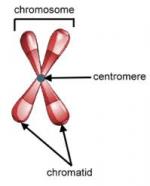|
This section contains 1,258 words (approx. 5 pages at 300 words per page) |

|
A chromosome banding pattern is comprised of alternating light and dark stripes, or bands, that appear along its length after being stained with a dye. A unique banding pattern is used to identify each chromosome and to diagnose chromosomal aberrations, including chromosome breakage, loss, duplication or inverted segments. In the 1950s, chromosomes from the cell's nucleus were identified with a uniform (unbanded) stain that allowed for the observation of the overall length and primary constriction (centromere) of each chromosome, as well as a secondary constriction in chromosomes 1, 9, 16 and the acrocentrics (chromosomes whose centromeres are near the tips). The staining techniques used to make the bands visible were developed in the late 1960s and early 1970s.
Chromosome Structure
To understand what chromosomal bands represent, it is helpful to understand the structure of chromosomes. Eukaryotic chromosomes are composed of chromatin, a combination of nuclear DNA and proteins. At...
|
This section contains 1,258 words (approx. 5 pages at 300 words per page) |

|


